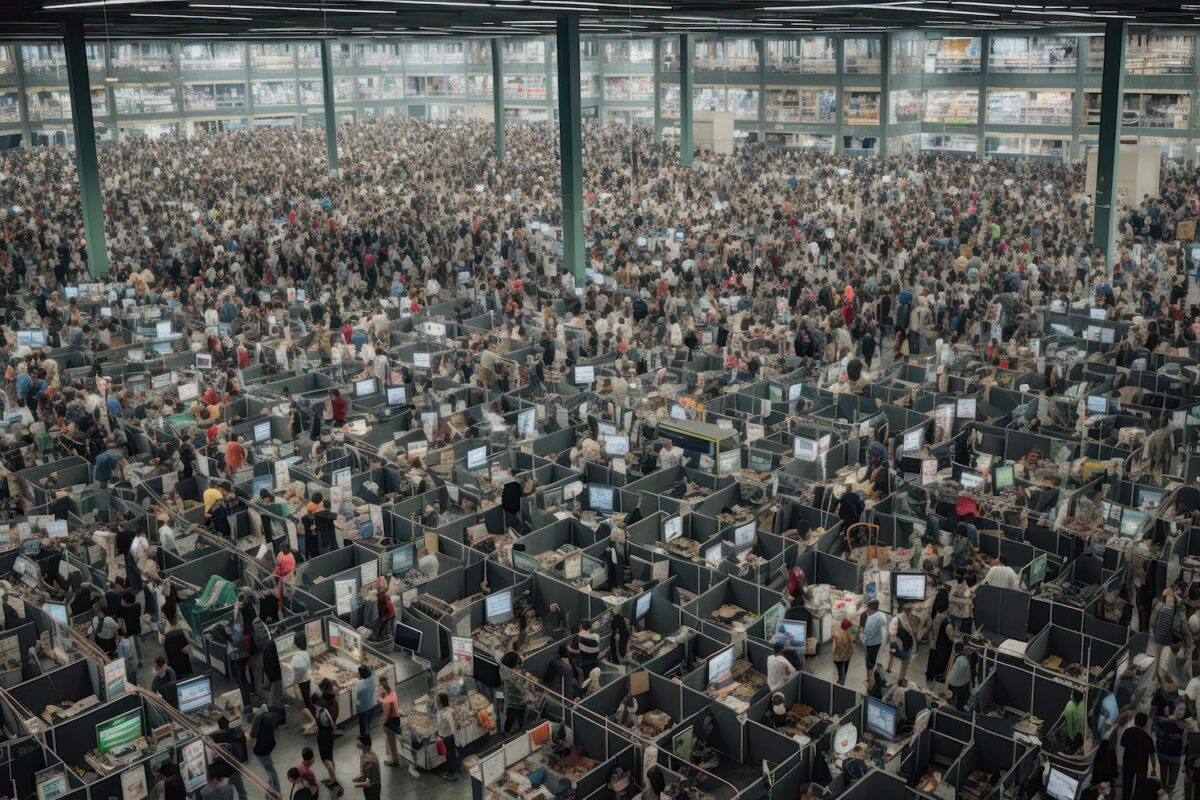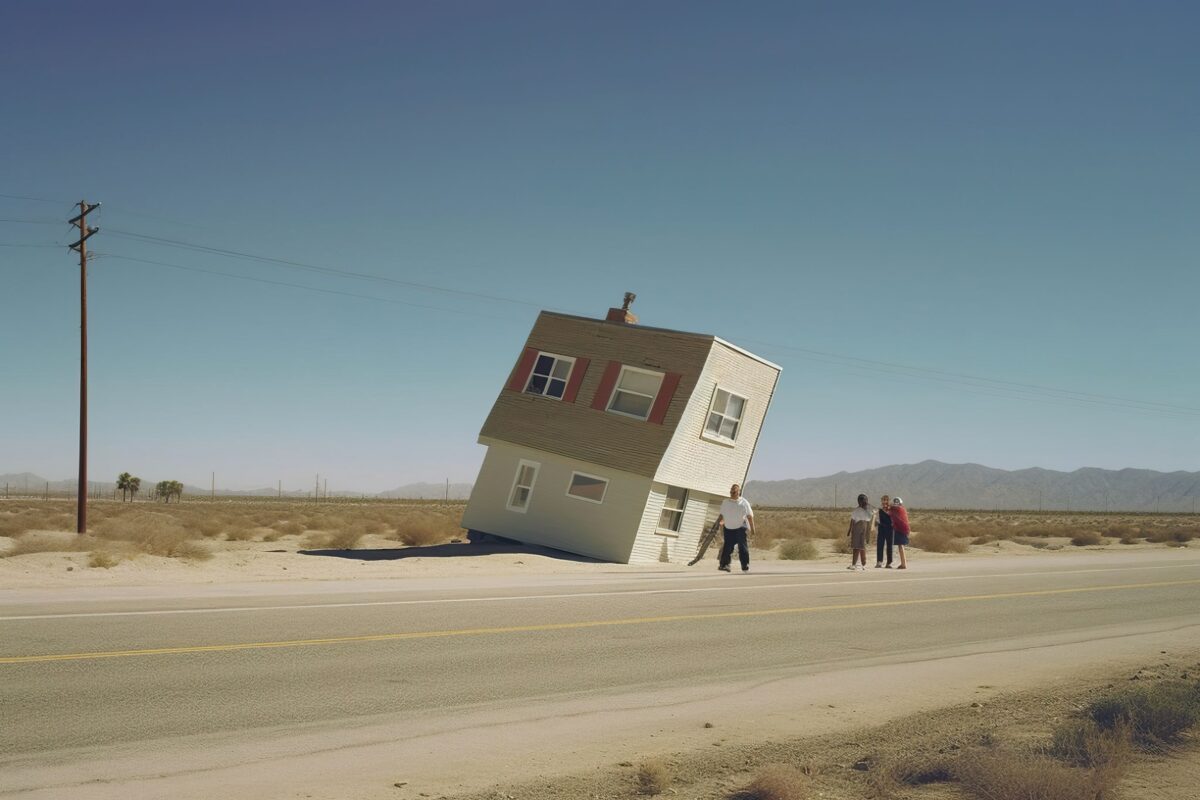If the prominence of AI art tools over the past year can be described as an uncharted ocean of creative possibilities, then the Web3 photography platform Fellowship is one of the boldest and most capable ships to navigate its waves. In April, the platform launched Post-Photographic Perspectives, its inaugural AI-focused art show featuring the mind-blowing and socially introspective works of artists such as Roope Rainisto, Katie Morris, Jess Mac, Charlie Engman and more.
The sequel to that show, titled Acceptable Realities, arrives July 10 and consists of two parts, one devoted to the growing genre of AI video experiments and the other to AI photographic stills. The new project explores the ways in which AI continues to enable an expansion of the possibilities of the art of the lens. It features a roster of 14 artists, including Felipe Posada, Alkan Avcıoğlu, Beth Frey, Irina Angles, Frank Manzano, and more, whose work is curated by crypto art heavy hitters such as Grant Riven Yun Ivona Tau, Roope Rainisto, and Pindar Van Arman.
We sat down with Fellowship co-founder Alejandro Cartagena to talk about the platform’s second show, how and why the AI video scene is exploding, and what it takes to create real value for a Web3 community of holders .
nft now: Let’s dive into Acceptable Realities, the second installment of Fellowship’s Post Photographic Perspectives series. How does it feel to have had such a successful launch in April, and what feelings do you have on the eve of this second show?
Alejandro Cartagena: Fellowship has been around since 2021. We had long postponed the idea of a coin card because we thought: ‘What can we actually deliver?’ Then we saw this opportunity to build a series of exhibitions because there is so much talent out there, and we were looking for new artists all over the world. We said, ‘Okay, this is something we can commit to, and we can surpass this.’

The idea was that you buy the pass, and it’s an annual subscription. Here’s what we’re going to promise for this year. This is what we’re fully committed to, and boom, we’re on it. The commitment is to create three great collections. With this second we introduce video. It’s a series. It’s a commitment to the collectors who said, ‘Hey, we believe in the curation you do; go out and find great talent’, and that’s what we do for them.
Things evolve so quickly and exhibitions are rather dated in that sense. [These shows] talk about the technological moments when those images were created. In this second iteration, you see [AI] video, which, when we launched the first show video, really sucked. Now artists do things with video and they just go crazy. They are mixing tools. They combine CGI with 3D modeling, building their own Stable Diffusion models. That wasn’t there three months ago.
nft now: you have artists like Grant Yun and Ivona Tau and collectors like Studio137 and ayybee as part of the curatorial committee for the show. Aside from wanting to include well-known and respected artists and figures in the community, how did the Fellowship team decide who they wanted to be part of that group?
AC: After the first launch it was great. Everyone sold out their collections. The pressure was on. It’s from there, right? Or if you stay on the same level, you can’t go down. One of the things we came across over and over was these collectors and artists saying, Hey, if you need help, I’d love to see what you’re going to do next.
I have been on selection committees before. It’s a consensus of artists doing things that are really cool and collectors actually buying work. So it was a very difficult process because there were artists that we favored and they didn’t make it because there was no consensus among the collectors and artists.
But in the end, we think that’s the best way. I mean it’s not a DAO thing. It’s not about governance. What matters is which work resonates most at this particular moment. Let’s bring in opinion leaders to help us determine who those people are. The people who were selected were selected because they resonated best with the people we invited.
nft now: Some may feel that including Grant Yun, a minimal Precisionist performer who doesn’t work in the AI space, is a curious choice for the show’s selection committee. How do you react to that?
“It’s not about finding like-minded people in aesthetics, but like-minded people in the dedication to their art and their practice.”
Alejandro Cartagena
AC: I’ve been following Grant for a while and we’ve had short dialogues about photography in the past. He’s a dedicated artist and while he doesn’t talk too much about AI, we’ve seen him collect AI work and he’s interested in looking at that world. Most importantly, he knows what he’s doing. We want him to notice people that he feels that too on the level of what he’s doing. That’s what it’s all about. It’s not about finding like-minded people in aesthetics, but like-minded people in the dedication to their art and their practice.
now: Let’s talk about the thematic guidelines at work behind Acceptable Realities. AI art proponents are still engaged in heated conversations about the legitimacy of the movement and what is and isn’t “acceptable” as art. How do these concepts interact with the types of works the artists have created for the show?

AC: For me, it was this riddle room. I’ve never heard of this idea, an “acceptable reality.” What does that even mean? That was perfect for me to do [capture] the moment we live with AI art. What is this? And with ‘reality’ we wanted to play with the photographic character of these images. Because they aren’t real. Obviously they’re not real, but they’re acceptable enough that you might be able to to consider them really. It’s a play on words, a play on the photographic medium, a play on the AI medium, and where those things collide.
nft now: Acceptable Realities begins with AI video artist submissions and gives collectors three days to engage with that art before the still images portion of the show begins. Why make more room for AI video in this show?
AC: It’s more than a new trend, it’s the way video works compared to still images. Video takes time. Video needs a little more space so people can understand what they’re watching. So from June 10th there will be a solo show by one artist every day for four days, and it’s all auctions.
The minimum bid is 0.01 ETH so it is really affordable. Not all artists produce the same number of works, so we wanted to have a sales engineer who respects the artwork itself. One of the things we’re super focused on at Fellowship is creating a truly unique acquisition experience for collectors. You will view the works a week in advance, so that you can come and see what you like. You can also keep a watch list of pieces that come to mind. Once the bids have started, you can filter from highest to lowest bids.
We create an experience that focuses on efficient collection. To me, that’s Web3’s ethos, creating an efficient art acquisition market.
“There’s an uneasy feeling about the images because you feel it’s wrong. But you can’t stop trying to understand what you’re looking at. And that sensation is what’s exciting about AI video.”
Alejandro Cartagena
nft now: The technological leaps AI art tools are making today are insignificant by any measure. What was it like for you, as someone steeped in the art and history of photography and imagery, to see this evolution take place?
AC: It’s, it’s fascinating to watch. The sense of uncertainty is something fascinating in art to me. For commercial use, I’m sure people would find it worthless; they say it doesn’t even display correctly and so on. But that’s actually really cool. That it’s not factual, but still you understand. And that is the power of art. It’s about suggestion.
AI video does just that. It taps into our collective consciousness of what we’ve seen as beer advertising, as car advertising. So AI, like stills, takes familiar ideas but pulls and pushes them out half-baked. There is an unease in the images because you feel it is wrong. But you can’t stop trying to understand what you’re looking at. That thrill is what’s exciting about AI video. Stills have been doing this for a while, but seeing it in video, seeing that extra layer of unknown story — that’s what’s new about video for me right now.

